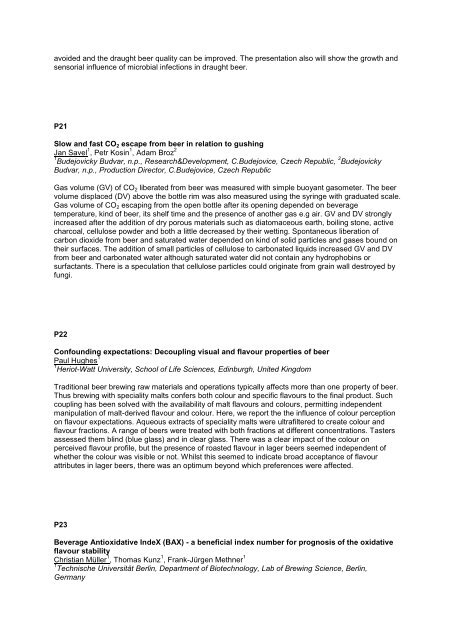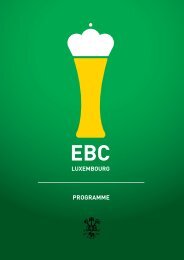here - the 34th European Brewery Convention
here - the 34th European Brewery Convention
here - the 34th European Brewery Convention
You also want an ePaper? Increase the reach of your titles
YUMPU automatically turns print PDFs into web optimized ePapers that Google loves.
avoided and <strong>the</strong> draught beer quality can be improved. The presentation also will show <strong>the</strong> growth and<br />
sensorial influence of microbial infections in draught beer.<br />
P21<br />
Slow and fast CO 2 escape from beer in relation to gushing<br />
Jan Savel 1 , Petr Kosin 1 , Adam Broz 2<br />
1 Budejovicky Budvar, n.p., Research&Development, C.Budejovice, Czech Republic, 2 Budejovicky<br />
Budvar, n.p., Production Director, C.Budejovice, Czech Republic<br />
Gas volume (GV) of CO 2 liberated from beer was measured with simple buoyant gasometer. The beer<br />
volume displaced (DV) above <strong>the</strong> bottle rim was also measured using <strong>the</strong> syringe with graduated scale.<br />
Gas volume of CO 2 escaping from <strong>the</strong> open bottle after its opening depended on beverage<br />
temperature, kind of beer, its shelf time and <strong>the</strong> presence of ano<strong>the</strong>r gas e.g air. GV and DV strongly<br />
increased after <strong>the</strong> addition of dry porous materials such as diatomaceous earth, boiling stone, active<br />
charcoal, cellulose powder and both a little decreased by <strong>the</strong>ir wetting. Spontaneous liberation of<br />
carbon dioxide from beer and saturated water depended on kind of solid particles and gases bound on<br />
<strong>the</strong>ir surfaces. The addition of small particles of cellulose to carbonated liquids increased GV and DV<br />
from beer and carbonated water although saturated water did not contain any hydrophobins or<br />
surfactants. T<strong>here</strong> is a speculation that cellulose particles could originate from grain wall destroyed by<br />
fungi.<br />
P22<br />
Confounding expectations: Decoupling visual and flavour properties of beer<br />
Paul Hughes 1<br />
1 Heriot-Watt University, School of Life Sciences, Edinburgh, United Kingdom<br />
Traditional beer brewing raw materials and operations typically affects more than one property of beer.<br />
Thus brewing with speciality malts confers both colour and specific flavours to <strong>the</strong> final product. Such<br />
coupling has been solved with <strong>the</strong> availability of malt flavours and colours, permitting independent<br />
manipulation of malt-derived flavour and colour. Here, we report <strong>the</strong> <strong>the</strong> influence of colour perception<br />
on flavour expectations. Aqueous extracts of speciality malts were ultrafiltered to create colour and<br />
flavour fractions. A range of beers were treated with both fractions at different concentrations. Tasters<br />
assessed <strong>the</strong>m blind (blue glass) and in clear glass. T<strong>here</strong> was a clear impact of <strong>the</strong> colour on<br />
perceived flavour profile, but <strong>the</strong> presence of roasted flavour in lager beers seemed independent of<br />
whe<strong>the</strong>r <strong>the</strong> colour was visible or not. Whilst this seemed to indicate broad acceptance of flavour<br />
attributes in lager beers, t<strong>here</strong> was an optimum beyond which preferences were affected.<br />
P23<br />
Beverage Antioxidative IndeX (BAX) - a beneficial index number for prognosis of <strong>the</strong> oxidative<br />
flavour stability<br />
Christian Müller 1 , Thomas Kunz 1 , Frank-Jürgen Methner 1<br />
1 Technische Universität Berlin, Department of Biotechnology, Lab of Brewing Science, Berlin,<br />
Germany





